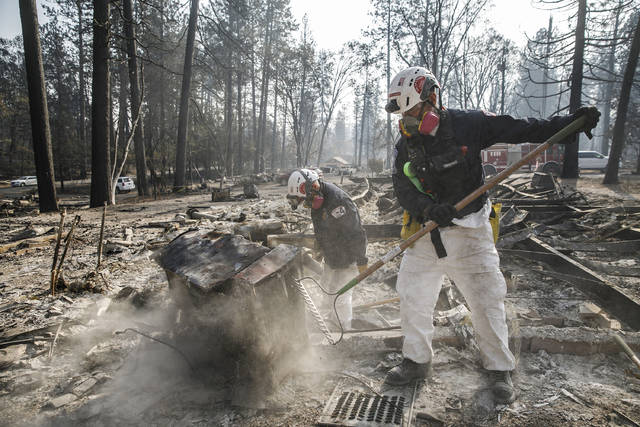CHICO, Calif. — As every day goes by, searchers are finding fewer human remains in the rubble of California’s deadliest wildfire.
At the same time, they are slowly narrowing the list of the missing, which on Monday stood at 203 yet still down by about 1,000 from last week.
But amid this work, authorities are coming to terms with the possibility that the search for victims of the Camp fire might never be complete and that some human remains won’t ever be recovered.
“Is it possible that there could be a circumstance where someone was completely consumed by fire and therefore we wouldn’t have something that we could collect? I would say it is within the realm of possibility, unfortunately,” Butte County Sheriff Kory Honea said Monday.
“There’s nothing easy about this. This is just an unprecedented situation,” he added.
More than two weeks after the fire swept through this area, destroying most of the town of Paradise and leveling more than 14,000 homes, officials have found the remains of 88 people and confirmed that 2,700 people reported missing by friends or family were in fact alive.
Officials have not said how much of the fire zone has been searched by forensic teams but noted that the declining amount of human remains being found is encouraging.
“We have made good progress in covering the vast majority of the area that we need to cover,” Honea said.
Investigators have had an extraordinarily difficult time sifting through ashes to find remains. The heat of the fire left remains so charred that only bones, or even bone fragments, have been recovered.
Without intact skulls being found, investigators can’t use dental records to make identifications, and instead have had to resort to the extraordinary use of extracting DNA samples from the victims and attempting to match them to genetic material of families using rapid DNA analysis.
As of last week, tentative identifications had been made on more than 50 of them, but they awaited DNA confirmation.
The toll of the dead has gone up and down, in part owing to the difficulty of the search. In one case, an error resulted in duplicate case numbers being assigned to two fire victims.
In another, a forensic analysis of remains thought to be of two individuals turned out to be the remains of three.
Workers are sometimes going back to sites twice or even three times to make sure they’re not missing anything. Anthropologists have told the sheriff that it is likely that at least some trace of human remains can be recovered in most cases.
“This illustrates how difficult this task is. This illustrates how painstaking the work is and how diligent the teams including the forensic pathologists are,” the sheriff said. “We’re doing everything in our power to recover the remains, everything in our power to identify the remains and return them to their family members.”
It used to be that DNA analysis could take months before answers would firm up. But now DNA analysis can be done within a matter of hours, said Jim Davis of Ande, a Massachusetts-based company that specializes in rapid DNA analysis.
Davis said his company has been asked by the sheriff to use its rapid DNA analysis method to help identify victims _ the first time his company has been asked to do so in a mass-casualty event.
He’s working with the coroner’s office in Sacramento County to collect tissue samples through the autopsies of the deceased; 80 percent of the time, those samples are usable for DNA analysis.
Butte County sheriff and California Department of Justice officials are coordinating the collection of DNA samples from living relatives, which can take some time to collect.
“Matching these two sets of (DNA samples) allows us to provide a positive identification of victims in a matter of hours,” Davis said.
The search effort is being conducted by more than 500 people, including coroner’s investigators, urban search and rescue officials, firefighters and forensic anthropologists.
Officials are searching for remains using a three-step process _ covering residences where they have information that human remains might be located; other locations, such as mobile home parks with a higher degree of possibility that there are human remains; and combing any location where people may have been, even if it’s in a less dense part of town.
As for winnowing the list of the unaccounted, there’s a team of investigators, the sheriff said, searching for the missing. The process includes re-contacting individuals who reported missing family and friends, searching various databases to see if the missing can be located and finding social media accounts to see if they’ve checked in.
The rains have made searching for human remains more difficult. Typically, as crews go through debris they scoop it into a screen and sift it, looking for bone or bone fragments.
The rain has mixed in with the ash and formed a claylike substance. To deal with that, officials have had to bring in water and gently wash away the clay to expose any human remains in the debris.

